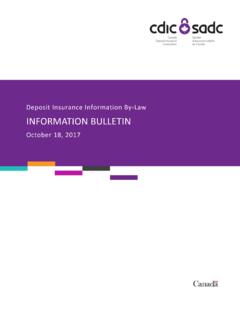Transcription of CDIC Resolution Plan Guidance (Summary)
1 CDIC Resolution plan Guidance ( summary ). CDIC's role in resolving large banks In 2015, the Government announced that Canada's domestic systemically important banks ( D-SIBs ). would be responsible for preparing Resolution plans, which would ensure the continuity of critical banking services to Canadians in the unlikely event of a large bank failure. As Canada's bank Resolution authority, CDIC assists the D-SIBs by providing Guidance and articulating expectations for the content and implementation of Resolution plans. CDIC is also responsible for reviewing and assessing these plans to ensure banks develop feasible Resolution plans, and work to address any obstacles that would prevent the orderly Resolution of the bank in a crisis event. CDIC is ultimately responsible for selecting and implementing a Resolution strategy in the event of failure, taking into account the circumstances at the time.
2 What is the purpose of Resolution plans? In keeping with international best practices, including the Financial Stability Board's ( FSB ) Key Attributes for Effective Resolution Regimes for Financial Institutions, CDIC's Guidance is essentially a blueprint for a comprehensive Resolution plan , and outlines a clear process to steer and support D-SIBs during the development of their plan . The purpose of a Resolution plan is to allow authorities (CDIC is the Resolution authority in Canada) to resolve a financial institution in an orderly manner that will maintain stability of the economy and protect taxpayers from exposure to loss. The Resolution plan serves as a guide to help achieve an orderly Resolution by outlining, in detail, a Resolution strategy along with other important elements listed in the next section.
3 As noted in the FSB's Guidance on Developing Effective Resolution Strategies, a Resolution strategy and Resolution plan should help facilitate the effective use of Resolution powers by authorities and help make the Resolution of the financial institution feasible. The Resolution planning process is an iterative process that aims to continuously improve the quality and feasibility of the plans to ensure they are current. FSB's consultative document Recovery and Resolution Planning: Making the Key Attributes Requirements Operational addresses this in more detail. In the unlikely event of a financial crisis, Resolution plans will be an important tool used by CDIC to protect depositors, the Canadian financial system and taxpayers' exposure to loss.
4 What does CDIC ask the banks to do? To ensure that D-SIBs maintain robust Resolution plans, CDIC has asked them to provide a wide range of information on their operations to assess the means by which their legal, financial and operating structure can facilitate an orderly Resolution of a range of severe but plausible events. This includes the banks': Corporate profile Strategies to ensure continuation or wind-down of material operations Scenario analysis Operational feasibility of the strategies outlined in the plan Additionally, banks are expected to detail and remediate any major impediments to the successful implementation of their plans. In setting the requirements for plan development, CDIC is guided by the international work efforts to improve the resolvability of systemically important financial institutions, including FSB Guidance on operational continuity, loss absorbency, funding, cross-border cooperation, effective resolutions strategies, and removing obstacles to resolvability.
5 CDIC has set out the following principles to guide DSIBs in the development of their Resolution plans: Accountable: The bank's board of directors is responsible for ensuring that a credible and feasible Resolution plan is in place and can be operationally implemented. Strategic: the plan must be strategically focused and reflect senior management's conclusions and observations about implementation given the bank's unique legal, financial, and operational structure. Comprehensive: Resolution plans must take into account the specific characteristics of the bank including its size, complexity, and geographic footprint. Implementable: Each plan must demonstrate practical implementation including the extent to which crisis management capabilities have been, or can be, tested.
6 Current: Resolution planning is an iterative process that requires regular updating to reflect the current state of the bank as well as the legal and regulatory environment in which it operates.







